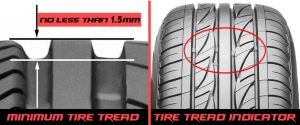Wheels and Tires are, strangely enough, usually some of the most overlooked and underestimated parts of a vehicle when it comes to appreciation and maintenance. You would think that the only part of a car that, in normal circumstances, has any actual contact with the driving surface would be well looked after, but the exact opposite is often the case! Here are 3 common problems that infrequent care of tires can cause, along with tips and tricks to help you prevent them.
Under-inflated Tires

Tyre pressure is possibly the most crucial part of ensuring performance efficiency for the serviceable life of the product. Both under and over-inflation is damaging: they lower your tires’ ability to grip the driving surface, leading to problems such as skidding, and in tragic cases, overturning and similar accidents, especially when turning corners at high speeds. They can also lead to irregular and increased wearing of tyre tread and damage to the wheels. To ensure your tires are inflated to the right degree for your car, check your manufacturer’s recommendations, as the optimum pressure level is particular to each individual model. It is important to check your tyre pressure on a fortnightly basis, and only when they’re not warm from having been driven.
Overstressed Tires

Overstressing of tires can occur due to speeding and overloading. Both can lead to irreparable damage in tires: the phrase “burning rubber” isn’t idly used! Tyre temperatures can increase considerably if the pressure in the tyre is not enough to support the load, leading to major damage to the physical structure of both the tyre and the wheels, and even to tyre failure. The best way to prevent this would, of course, be to avoid the causes. If carrying loads up to, or close to the maximum level your car can carry is unavoidable, or if you are forced to drive under conditions of high speed, make sure to adjust the tyre pressure according to the guidelines of your vehicle’s manufacturer.
Tread Wearing

And last but not least, worn tires are dangerous: they can lead to “aquaplaning”, a phenomenon in which a layer of water builds up in between the wheels and the road, reducing traction and control and resulting in the vehicle becoming, for all practical purposes, an out-of-control sled. It is very important to change your tires before they reach the minimum depth advisable under weather conditions, as well as that required by law. Tread Wear Indicators, which are elevated strips found in the major longitudinal tread grooves, are the best judges of tread depth. Go by them to determine the correct time to change your tires. A useful tip is to change tires with 3 mm of tread depth left in summer, and 4 mm in winter.
Wheels and tyre packages that offer the best of both for your car are life-savers. Get the best deal you can by having your vehicle checked by a tyre-service professional, who will help you make the right choice in wheels and tyre packages, such as the ones offered by us. Regular servicing and the best wheel and tyre package help ensure better care for your wheels and tyres, and give you a smoother, safer, more enjoyable ride. We hope this article helped you! For information on how you can look after your rims or if you’re just looking to improve the look of your car or 4×4 vehicles, head on over to AutoCraze.com.au and let us help you pick out the perfect set of custom wheels for your ride!










